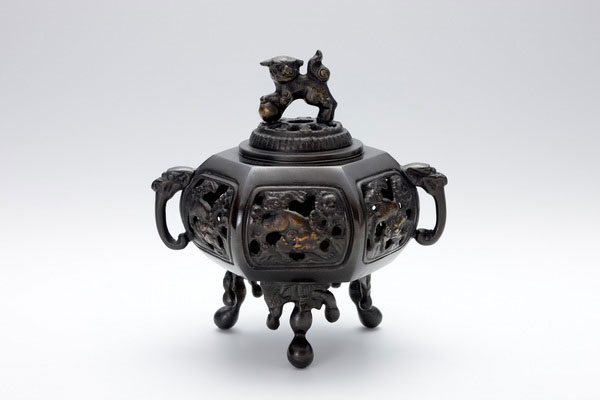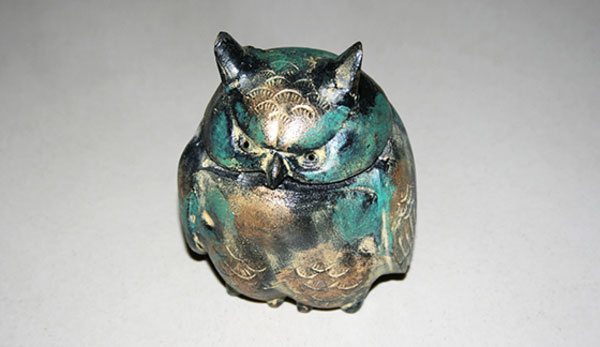
- Metal works
- Toyama
Takaoka copperware Takaoka doki
Strength, delicacy and flexibility
from large Buddhist statues to delicate accessories
Description
What is Takaoka copperware ?
Takaoka copperware (called Takaoka doki in Japanese) is a type of copperware produced in the area around the city of Takaoka in Toyama prefecture. The various products range from small items such as indoor ornaments, Buddhist tools, and vases to larger items such as temple bells, Buddhist statues, and copper statues.
Takaoka copperware is said to be top class among Japan's copperware production. Most of the anime character statues installed in urban revitalization projects across the country are made with Takaoka copperware. Therefore there are many people in Japan who have unknowingly seen Takaoka copperware. There is also a lively export market and Takaoka copperware is highly regarded in the many countries to which its products are exported.
The notable features of Takaoka copperware are the skillful hands-on casting techniques of the artisans and the polishing, metal carving and inlaying production techniques. These techniques have been combined and developed to create a wealth of styles. People are fascinated when they see the strength, delicacy, and flexibility of Takaoka copperware, which are made so that it takes on a deeper expression over time and can be enjoyed as it changes throughout the years.
History

The origin of Takaoka copperware goes back more than 400 years to the Edo period (1603-1868). In 1609, Toshinaga MAEDA, the second generation lord of the Kaga domain (contained modern day Toyama prefecture) acquired Takaoka Castle. In 1611, seven casting masters were brought to Takaoka in order to develop the area around the castle. A casting plant was built in Takaoka by the casting masters, who first started by producing iron goods for daily life, such as farm tools and pots. Later, copperware production began sometime between 1830 and 1848.
During the Meiji period (1868-1912), numerous items of Takaoka copperware were displayed at World Expositions in Austria and European cities like London and Paris, which created a craze for Japanese style products. The Meiji and Taisho periods (1912-1926) saw the active production of ornaments and tea ceremony implements. As Takaoka copperware became well known in Japan as artistic handicrafts, the increase in demand for Takaoka copperware gifts led to much development.
In 1975, Takaoka was designated as Japan's first national traditional handicraft production area.
General Production Process
- 1. Model production
Casting involves melting the metal at a high temperature, after which it is poured into a template with the desired shape. Casting starts with the production of a model.
Because the model becomes the basis of the final product, it is made according to sketches or a blueprint using easy-to-process materials such as wood, plaster, clay or resin.
- 2. Loam
Based on the model, a template is made in order to pour in the melted copper using fire-resistant materials. The model is coated with a release agent, then hardened layers of paper clay and roughing loam (sand) are applied over top. Iron bars or other materials may be placed inside the model for reinforcement. The template is completed after it hardens and thoroughly dries.
- 3. Combining templates
The template is made from setting the external template together with the internal template, which is slightly smaller than the model. It is possible to control the thickness of the cast product which is determined by the gap between the external template and the internal template. The uniformity of this gap will make the finished casting product more beautiful.
- 4. Completion of external template
After drying a sufficient amount, the external template is completed by being removed from the model.
- 5. Refining and melting
Refining involves removing foreign matter and increasing the purity of the metal. A high temperature is used to not only refine the metal, but also to make a hot molten metal by melting solid metals.
- 6. Casting
The process of pouring molten metal into the template is called casting. During the manufacturing of Takaoka copperware, a copper alloy molten metal at a temperature of about 1150-1250℃ (about 2102-2282℉) is poured into the template. If the temperature is too high, the surface of the completed cast will be rough, which may inhibit its beauty, so temperature control during casting is incredibly important. There are also dangers that lead to accidents due to the high temperatures, so this work requires a lot of attention.
- 7. Template removal and finishing process
After the molten metal has been poured into the template during casting, the copper is left to cool down. When it is completely cooled and solidified, the external and internal templates are removed, and the product is taken out.
- 8. Polishing, metal carving, inlaying, and coloring
The finishing touches are polishing, metal carving, inlaying, and coloring.
Takaoka copperware requires not just physical polishing but also chemical polishing, which smooths out any uneven areas through the application of an acid solution.
For metal carving, a chisel is used to engrave a design into the surface of the metal. Metal castings with carvings are called karakane imono (bronze casting) and are said to have originated with Takaoka copperware.
Inlaying is a decorative technique in which the surface of the product is shaved and overlaid with another metal. The types of inlaying include line inlays, when lines are overlaid with gold and silver, cut and insert inlays, when holes made in the surface are overlaid and brazed with another metal, and high relief inlays, when bulges are made in the surface.
Coloring involves using natural coloring materials and chemicals that have copper rust colors and other colors to bring out the characteristics of bronze.
Where to Buy & More Information
Takaoka Doki Museum
-
Address
-
Tel.+81-766-30-0850
-
ClosedOpen every day
-
Business Hours9am to 5pm
-
Website
See more Metal works
- Nambu ironware
- Takaoka copperware
- Yamagata cast iron
- Sakai cutlery
- Tokyo silverware
- Echizen cutlery
- Osaka naniwa pewterware
- Tosa cutlery
- Tsubame-tsuiki copperware
- Shinshu Forged Blades
- Banshu-miki cutlery
- Higo inlays
- Echigo-sanjo cutlery
- Echigo-yoita cutlery
- Chiba Artisan Tools
- Tokyo antimony craft































































































































































































































































































